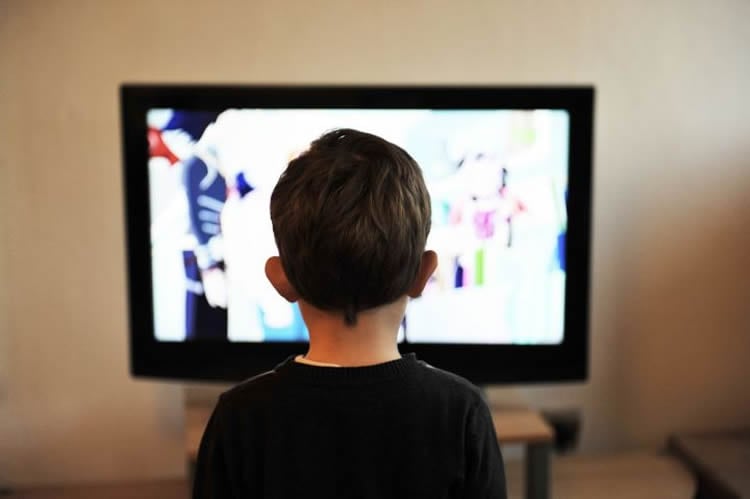Summary: Poor language skills associated with watching TV for more than three hours a day in 11 year olds, researchers say.
Source: La Trobe University.
Watching more than three hours of television a day is associated with poorer language skills for 11-year-olds, according to a new international study.
The study, by researchers from England’s Newcastle University, Scotland’s Queen Margaret University and La Trobe University and Griffith University in Australia, also found children who watch less than three hours of TV a day when they start primary school are more likely to communicate their ideas effectively when they move on to secondary school.
Dr Elizabeth Westrupp from La Trobe’s Judith Lumley Centre was one of the researchers involved in the Australian-funded study that suggests that most five-year-olds can watch up to three hours of television a day with few ill effects on their language skills by the time they leave primary school.
The researchers used data from thousands of children in the UK’s Millennium Cohort Study and found, while watching less TV is generally better, TV has a different effect depending on the children’s language skills at 11 years.
In particular, while it appears to make little difference to the children with higher language scores, it is strongly associated with the performance of those who have poorer language skills later on.
The researchers looked at the impact of parental involvement with children when they were aged three and five and then examined how well they were able to communicate their ideas at 11.
They asked parents how often they:
- Read to their children
- Told stories
- Visited the library
- Took them to the park
- Watched television – for three hours a day or less
Reading to young children was, on average, associated with better performance, but again it had much less of an effect on children with the best language scores at 11 years and, correspondingly, much more of an effect on those who were doing less well.
The study also found that poverty and the more siblings a child had were negatively associated with language development at the age of 11.
Lead researcher James Law, Professor of Speech and Language Sciences, in Newcastle University’s School of Education, Communication and Language Sciences said:
“As researchers, we’re really interested in looking at things which parents can do which can make a positive impact on helping their child develop good language skills.
“The television effect was a very interesting finding and we saw it had a bigger impact for the children with lower language skills, but made little difference to those who had had higher levels of language.

“It suggests that the Government and local authorities might want to consider how they get messages about setting limits on television and reading to children across to families who may need support in issues such as delayed language development.
“Television isn’t the enemy. My personal view is that it’s how you watch it that’s important. If you are actively watching a program with your children and they’re talking about what’s happening, you’re asking and answering questions, then I think that’s fine and will be a positive experience for both of you. It’s when children are sat in front of it for hours with no input – in effect an electronic babysitter – that I think it becomes problematic.”
Background
The study was conducted to find out if a different way of analysing data could lead to more targeted approaches in helping children with delayed language development. The researchers found their quantile method could help target areas that needed particular attention – something that would have been impossible from traditional models that only use average findings for the whole population.
The research used the Millennium Cohort Study, a cohort of children born in the UK between September 2000 and January 2002. The research looked at the language development of 5,682 children, measuring their language abilities using the British Ability Scales assessment.
Source: La Trobe University
Image Source: NeuroscienceNews.com image is adapted from the La Trobe University news release.
Original Research: Abstract for “Early Home Activities and Oral Language Skills in Middle Childhood: A Quantile Analysis” by James Law, Robert Rush, Tom King, Elizabeth Westrupp, and Sheena Reilly in Child Development. Published online February 23 2017 doi:10.1111/cdev.12727
[cbtabs][cbtab title=”MLA”]La Trobe University “How Much TV Is Too Much For the Developing Brain?.” NeuroscienceNews. NeuroscienceNews, 16 May 2017.
<https://neurosciencenews.com/tv-brain-development-6691/>.[/cbtab][cbtab title=”APA”]La Trobe University (2017, May 16). How Much TV Is Too Much For the Developing Brain?. NeuroscienceNew. Retrieved May 16, 2017 from https://neurosciencenews.com/tv-brain-development-6691/[/cbtab][cbtab title=”Chicago”]La Trobe University “How Much TV Is Too Much For the Developing Brain?.” https://neurosciencenews.com/tv-brain-development-6691/ (accessed May 16, 2017).[/cbtab][/cbtabs]
Abstract
Early Home Activities and Oral Language Skills in Middle Childhood: A Quantile Analysis
Oral language development is a key outcome of elementary school, and it is important to identify factors that predict it most effectively. Commonly researchers use ordinary least squares regression with conclusions restricted to average performance conditional on relevant covariates. Quantile regression offers a more sophisticated alternative. Using data of 17,687 children from the United Kingdom’s Millennium Cohort Study, we compared ordinary least squares and quantile models with language development (verbal similarities) at 11 years as the outcome. Gender had more of an effect at the top of the distribution, whereas poverty, early language, and reading to the child had a greater effect at the bottom. The picture for TV watching was more mixed. The results are discussed in terms of the provision of universal and targeted interventions.
“Early Home Activities and Oral Language Skills in Middle Childhood: A Quantile Analysis” by James Law, Robert Rush, Tom King, Elizabeth Westrupp, and Sheena Reilly in Child Development. Published online February 23 2017 doi:10.1111/cdev.12727







